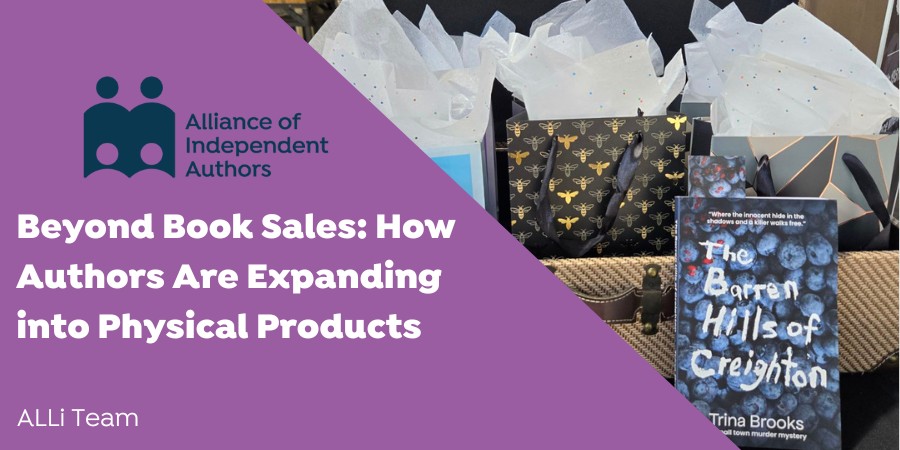Authors aren’t just selling books anymore—they’re selling an experience. Whether it’s special edition hardcovers, themed merchandise, or full-scale print businesses, more are turning to physical products to supplement their income and engage readers in new ways.
Literary merchandise has been around for years. A visit to the Globe Theatre’s gift shop or a quick search for Pride and Prejudice on Etsy proves that readers have always loved book-related items. But for most authors, merch was out of reach—too expensive to produce and too risky to stock.
That’s changing. With print-on-demand services, direct-to-reader sales, and crowdfunding platforms like Kickstarter, more authors are creating and selling physical products at a scale that was once only possible for major publishers. Some are experimenting with small merchandise lines, while others are opening fulfillment centers and running entire print operations.
Historical fiction author Melissa Addey, who literally wrote the book on this topic—Merchandise for Authors—creates products inspired by the worlds of her novels. Others, like Trina Brooks, bundle themed items with their books to create gift packages that encourage impulse buys.
For many, it’s not just about making extra money—it’s about building a deeper connection with readers.
Why Authors Are Turning to Merchandise

““There are some things merchandise should be doing for you, and if it’s not doing any of those things, then there’s a problem,” says Melissa Addey.
Merchandise isn’t just an add-on—it’s a strategic tool that can enhance an author’s brand, attract new readers, and strengthen existing relationships. But as Addey explains, it needs to serve a purpose.
“There are some things merchandise should be doing for you, and if it’s not doing any of those things, then there’s a problem,” she said. “The most important is that it needs to, at the very least, cover its expenses. There are other reasons why you might have merch, and obviously, you’d like it to make some money, but if it’s not covering expenses, then all you’re really doing is gifting. That’s a different thing.”
Good merchandise should do at least one of five things: bring in income, add credibility, increase readership, improve visibility, or enhance the reader experience. The best products check multiple boxes.
Bookmarks, tote bags, and coffee mugs are popular, but they can be ineffective unless part of a larger strategy. “I get a bit bored of those, as I think does everybody else, because there’s just an awful lot of them out there,” Addey said. Instead, she encourages authors to think beyond the obvious and create products that tie directly into their books.
The rise of print-on-demand services has made it easier than ever to experiment without financial risk. Platforms like Redbubble and Zazzle allow authors to upload a design and offer it on a range of products, from apparel to stationery, without holding inventory.
Beyond traditional merch, special editions and exclusive products can turn casual readers into superfans. Limited-run hardcovers, signed bookplates, and personalized packaging give readers a reason to buy direct rather than picking up a standard copy elsewhere.
Merchandise isn’t for everyone, but for those who approach it thoughtfully—focusing on what readers actually want rather than just slapping a logo on a product—it can be a powerful addition to an author’s business.
Merchandise That Works

“People see a book and wonder if they want to read it,” says Trina Brooks. “They see a gift package and think, ‘Oh my gosh, Mom’s birthday is coming up—this would be great.’”
The best merchandise isn’t just extra—it enhances the book’s world and deepens the reader’s experience.
Addey takes a creative approach, making sure each item feels like a natural extension of her books. “There is such a breadth of things that you can do,” she said. “At the back of my book, I have sixty different things that you could do, and some of them really go out of your comfort zone, like experiences.” Crime writers, for example, might offer shooting range experiences, while historical fiction authors could bundle their books with themed cookery classes.
For Brooks, merchandise is all about making her books stand out. She sells custom blueberry-scented soap inspired by the setting of her murder mystery, where the crime happens in a blueberry patch. She bundles it with a small bag of chocolate-covered blueberries and a bookmark. “People see a book and wonder if they want to read it,” she said. “They see a gift package and think, ‘Oh my gosh, Mom’s birthday is coming up—this would be great.’”
Print-on-demand platforms make it even easier to create unique products. Addey, whose books are set in medieval Morocco, took intricate designs from Berber jewelry, had them hand-illustrated, and uploaded them to Redbubble. Readers can now order dresses, cushions, and other items featuring the designs. “They can go on to hundreds of products,” she said. “On the books’ pages, I just put a little thing going, ‘You can explore the merchandise here.’”
Some authors create products that serve a functional purpose while keeping their books top of mind. Sean Levin, a creative writing tutor, sells writing maps—beautifully illustrated fold-out guides with location-based writing prompts. These small, portable products work as both a creative tool and a subtle brand reminder.
The key takeaway? The best merchandise isn’t just a random product with a book title slapped on it. It feels like a natural extension of the book itself, giving readers something they actually want while strengthening their connection to the author.
What to Avoid: Lessons from Bad Merch
Not all merchandise is a good idea. While a well-thought-out product can enhance a book’s appeal, a poorly chosen or low-quality item can do more harm than good. Addey, who has seen plenty of missteps in the world of literary merchandise, warns against rushing into products without careful consideration.
“One really important thing is to always order a prototype,” she said. “If it’s a crappy piece of quality stuff, it’s really going to undermine your brand. It’s going to make you look bad, even though technically that has nothing to do with you—it will still make you look bad.”
Addey has an entire section in her book on terrible merchandise choices, and a few standouts make it clear why authors need to think carefully about what they’re selling. One of the worst offenders? A pair of Sylvia Plath oven mitts. Given the poet’s death, the connection is in shockingly poor taste. Another baffling example was a Twilight-themed adult toy, an inappropriate choice for a series with a large teenage audience.
Beyond outright missteps, authors should be wary of generic, uninspired merchandise. “I get a bit bored of bookmarks and tote bags, as I think does everybody else, because there’s just an awful lot of them out there,” Addey said. While these items might seem like safe bets, they rarely stand out. Readers are more likely to engage with products that are unique and tied directly to a book’s themes, setting, or characters.
Quality matters, too. A cheap, poorly made product reflects badly on the author. It’s easy to get excited about creating merchandise, but cutting corners can backfire. Addey advises against selling anything without first ordering a sample to make sure it meets expectations.
The bottom line? Merchandise should be well-made, relevant, and something readers actually want. Otherwise, it’s just clutter—or worse, a marketing misstep that could have been avoided.
Crowdfunding and the Merch Boom

“With few exceptions, any writer not using Kickstarter is leaving money, often a lot of money, on the table,” says Russell Nohelty.
Crowdfunding hasn’t created demand for book-related merchandise—readers have always loved it—but it has made production more accessible. High-quality merchandise used to be the domain of big-name authors and franchises. Kickstarter has changed that, giving independent authors a way to test and fund products that would have otherwise been too expensive to produce.
Russell Nohelty believes crowdfunding should be a key part of an author’s business strategy. “With few exceptions, any writer not using Kickstarter is leaving money, often a lot of money, on the table,” he said. He argues that all authors—whether self-published or traditionally published—should consider it, particularly for special editions. Even authors in Kindle Unlimited can benefit by running a campaign before their exclusivity period begins, allowing non-Amazon readers a chance to purchase.
It doesn’t have to be complicated. Nohelty says a simple Kickstarter campaign can be launched in a day, without elaborate rewards, and still generate significant revenue. Crowdfunding isn’t just a way to finance books—it has normalized the idea that books can be part of a broader product line. Many authors are now using it to fund not just books but special editions, merchandise, and premium products that appeal to their most dedicated readers.
This shift has opened up opportunities that were once limited to major publishers. Authors now have the tools to create, market, and sell physical products at a scale that would have been unthinkable just a few years ago.
Business Strategy: How to Approach Merchandise
For authors thinking about adding merchandise to their business, the key is to start small and test what works. Addey recommends using print-on-demand services like Redbubble and Zazzle before committing to bulk orders. These platforms allow authors to upload designs and sell them on a variety of products without holding inventory or taking on financial risk.
“It would be so easy to set something up,” Addey said. “You don’t have to organize anything. Just create a design, and suddenly you have hundreds of products available.” For authors running crowdfunding campaigns, merchandise can also be introduced as a stretch goal rather than a major upfront investment.
Choosing the right product is just as important as how it’s sold. Merchandise works best when it aligns with a book’s themes or setting. Brooks, for example, ties her products directly to her story by bundling her murder mystery novel with blueberry-scented soap and chocolate-covered blueberries—both elements tied to the crime scene in her book. Addey has taken the same approach, adding a flowering tea to the final draft of her novel so she could sell real-life versions at events.
Pricing and cost strategy matter too. Merchandise shouldn’t be an afterthought that drains an author’s budget. For event giveaways, costs should be factored into the price of books. Bundling can also increase perceived value. Brooks’ gift package, for instance, encourages impulse buys because it’s an easy ready-made present.
Merchandise can be a valuable tool, but it has to make financial sense. Testing small, choosing products with a natural connection to the book, and factoring in costs are all steps toward making it work.
Conclusion
Authors don’t need to be JK Rowling to make merchandise work. The most successful products aren’t about having a massive fan base—they’re about creating something meaningful that enhances the reader’s experience and makes financial sense.
The best merchandise aligns with a book’s themes, whether it’s a special edition, a themed gift package, or a unique item tied to the story. Starting small is key. Print-on-demand services offer an easy way to experiment without financial risk, and bundling products with books can make them more appealing.
Addey’s advice for authors looking to explore merchandise is simple: “Use print-on-demand to test ideas, always prototype your products, and think beyond the obvious choices.” Readers don’t need another tote bag, but they might love something that immerses them in the world of the book.
For those willing to be strategic, merchandise can be a valuable part of an author’s business—not just as a revenue stream, but as a way to deepen connections with readers and make books stand out in a crowded market.
Thoughts or further questions on this post or any self-publishing issue?
 If you’re an ALLi member, head over to the SelfPubConnect forum for support from our experienced community of indie authors, advisors, and our own ALLi team. Simply create an account (if you haven’t already) to request to join the forum and get going.
If you’re an ALLi member, head over to the SelfPubConnect forum for support from our experienced community of indie authors, advisors, and our own ALLi team. Simply create an account (if you haven’t already) to request to join the forum and get going.
Non-members looking for more information can search our extensive archive of blog posts and podcast episodes packed with tips and advice at ALLi's Self-Publishing Advice Center.




